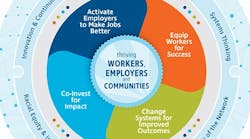This time around, recovery is going to look different.
“While the intent after the recession in 2008 was just to get everyone back to work, we need to have a wider view this time around,” explains Amanda Cage, CEO of The National Fund for Workforce Solutions. “The intent now should be to ensure that employees are getting high-quality jobs and ensuring workforce equity.”
Both of these issues describe the mission of The National Fund for Workforce Solutions. The organization works with a network of 30 collaboratives across the country in an effort to improve both business practices and public policies that strengthens the workforce. It also funds specific programs and companies.
They employ four solutions to advance workforce strategies:
1. Activate employers to help them design jobs that will help recruit and retain workers.
2. Equip workers for success which includes both traditional methods such as education and on-the-job training, but also help employers respond to the call for more diversity.
3. Be a change agent for the entire workforce ecosystem by exploring new ways of further strengthening the relationship between employers and educational institutions.
4. Provide funding and co-investments to organizations that are making progress in the field.
Cage, who has had a long career in workforce development in manufacturing, finds that many employers are trying hard to create better jobs and often just need some guidance. Her group will work directly with them by providing both funding and assistance. One company, Wepco Plastics, Inc. a family-owned manufacturer of plastic injection molded parts and rapid aluminum tooling based in Middlefield, Conn., has been working with The National Fund for Workforce Solutions for four years and has seen a marked improvement across a number of areas.
“We are focusing on providing better quality jobs,” says Amanda Wiriya , Manufacturing Support Manager at Wepco Plastics, Inc. “While we have many employees who have been with us for 10-18 years, we realize that soon people will retire and we need to focus on attracting new workers, and so we are taking a closer look at our values as an organization. We want to create a culture where people are improving their skills by doing jobs that are more interesting and challenging.”
The first thing Wepco did was to survey the workforce to get employees' opinions about their jobs, the company, and the culture. Next, they asked employees for feedback on what improvements the company could make. “We got a positive reaction from employees,” says Wiriya. “We had to gain the trust of the workforce by showing that we took the feedback seriously and incorporated it where we could and if we couldn’t we explained why.”
The process of figuring out where to start creating better jobs and offering a framework to achieve that is how The National Fund for Workforce Solutions works with companies. “We put together a framework of job quality that is on a continuum so that the companies can see themselves in this framework and then choose what works for them,” says Cage. The framework has three basic tenants:
1) Core Job Elements -- pay, stability and benefits
2) Opportunity – investing in workers by advancing their skills
3) Worker Voice – employees need to be empowered by understanding that their voice will be heard, and actions will be taken
“We do a lot of work trying to understand what motivates employers to improve the quality of their jobs,” says Cage. “They need to determine what is important to their workforce. Doing this doesn’t cost employers a lot and it has a huge impact on a number of workforce metrics including employee engagement, job satisfaction, attraction and retention.”
Wiriya would agree with that. “Transparency is what has mattered most to our employees. We have set up visual scorecards across the plant floor so that everyone can see production goals and know exactly what is going on. Prior to this employees didn’t know the connection between the parts they were making and which customers were receiving them.”
Other cultural improvements are taking hold as well. The company has been very consistent in surveying the workforce every six months and Wiriya said that they have seen progress on several fronts. One that has particular importance to her is how employees feel about the company. “When asked if you feel valued, this metric has gone way up since we started this journey."
Training was another way to improve job quality said Wiriya. A lot of employees had been doing the same job that they were originally hired to do. "There wasn’t a pathway to improve skills,” says Wiriya. “Now we are providing cross-training and skilling up our operators so that there are now managers of their machines and can perform a number of different jobs.”
The company is 50% toward its goal of upskilling its entire labor force and hopes in three years to have very limited positions at the entry-level.
However, the real goal is to provide better jobs. “With this new training and increase in productivity, employees are paid more, and this gives them a better quality of life,” says Wiriya.
A better quality of life starts with a better job, Cage points out. “When I would talk to employers who were having a hard time both recruiting and retaining talent, the issues of job quality would surface to the top of the discussion,” Cage says. “Many employers weren’t aware that either their corporate culture or their benefits packages were not meeting the needs of potential employees and were not competitive with other employers. It was a wake-up call.”
And the pandemic heightened this awareness as many essential workers were without the basic security systems that many jobs have such as healthcare benefits, paid time off and stable work schedules. “These conditions were more prevalent than most people thought, so we are seeing more action and activity to improve this situation.” At the top of this list is offering a livable wage that fits the community an employee lives in, Cage explains. Job security should be defined as the ability to pay a mortgage or rent and provide a basic standard of living.
Across the country, all communities are facing these issues and Cage said her organization and her partners are offering funding to groups to upskill workforces which will lead to better jobs. “We are learning together,” Cage says.






